
Red Rock, the Least-Famous Island in San Francisco Bay, Has a $25 Million Price Tag
Maybe it’s because Red Rock is so small, and so close to the Richmond Bridge that it doesn’t feel like an island, not a “traditional” island, anyway — which is to say studded with palm trees, lined with white sand and rimmed with azure water. To me, Red Rock is an incongruous lump in a corner of the Bay at once busy with ships, but remote when compared to the scenic and well-traveled Central Bay with its far-more-famous prison island — the subject of movies, tours and annual “escapes” — its glorious Cityfront, and its Golden Bridge, one of the seven wonders of the modern world. By contrast, Red Rock feels as if nature has risen from the depths in protest to offer rustic ornament along an industrial waterfront.
This is certainly not the description Realtors are using to describe Red Rock, which is currently for sale for a cool $25 million, as reported by the New York Times: “‘We believe this is like owning a Leonardo da Vinci or a Rothko,’ said a San Francisco real estate broker who represents the seller. ‘This is something someone would want in their portfolio like art or a sculpture.'”
Red Rock as art? As a notch on a billionaire’s bedpost? As yet another symbol of extravagant wealth run amok? As the intersection of development vs. natural preserves? Or are we overthinking it (sorry to be so dramatic) and ascribing too much meaning to a hunk of rock plopped in a corner of the Bay, a slice of nature indifferent to humans? Is Red Rock simply a shrubby slab to be avoided and appreciated as one sails by, as a mark to be rounded during the Three Bridge Fiasco?
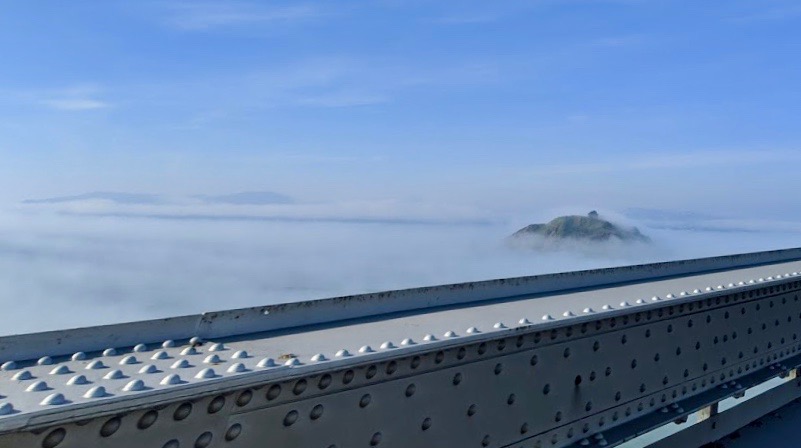
“The dream of island ownership has long captured the imagination of the wealthy and famous,” reported the Times on Christmas Eve, perhaps suggesting a last-minute gift idea for the uber-wealthy. “Celebrity owners of private islands include Richard Branson, Johnny Depp and George Clooney. Private Islands Inc., a real estate website, lists 607 that are on the market or recently have sold, 116 of them in the United States. ‘Americans like their ownership. They’re proud,’ said a Canadian who owns 13 islands himself in Canada, Belize and Fiji. ‘The idea of having your own island really fits into that American entrepreneurial spirit.'”
The Times acknowledged the superior fame of Red Rock’s kin. “Nearby islands have become famous — Alcatraz, the former federal penitentiary that housed hardened criminals, is known as ‘The Rock.’ Others serve recreational purposes, like Angel Island, a former military outpost and immigration center that is now a state park. But Red Rock, the only privately owned island in San Francisco Bay, is more of an idle curiosity.”
Well said. Red Rock is random, a head scratcher, a small, humble wonder hidden in plain sight.
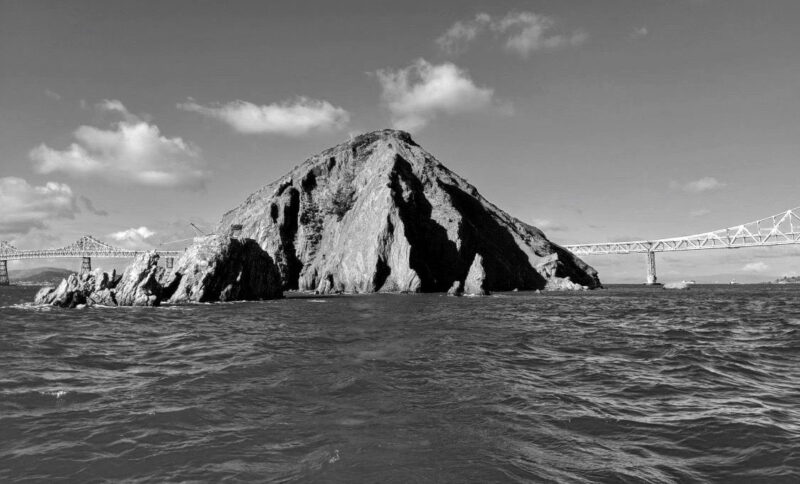
I like to think of Red Rock not as an island, but as a small mountain peak gazed upon while walking in the valley now known as San Francisco Bay. “When the first humans arrived in San Francisco, the last glacial period was not yet over, and the sea level was 300 feet lower than it is now,” wrote Bay Area author Gary Kamiya in his book Cool Gray City of Love.
“The Bay was dubbed the Franciscan Valley by archeologists. A mighty river ran through the Golden Gate, thundering in waterfalls and cascades, its relentless force carving out Angel Island from Tiburon. This vanished river flowed through a coastal prairie, the Farallones Plain, that extended all the way to the Farallon Islands, 28 miles away, where it emptied into the sea.”
Even as a mountain, Red Rock’s celebrity would likely be dwarfed by larger peaks, but I imagine it would retain some charm through its modesty and anomalous placement in the valley. In fact, I include Red Rock among an archipelago of small mountains in the northern corner of the Bay — this includes the Marin Islands (aka East Marin and West Marin) to the north, along with East and West Brother Island off the east shore and The Sisters to the west, with Brooks Island, off Richmond, being the southern extreme of this particular island/mountain nation.
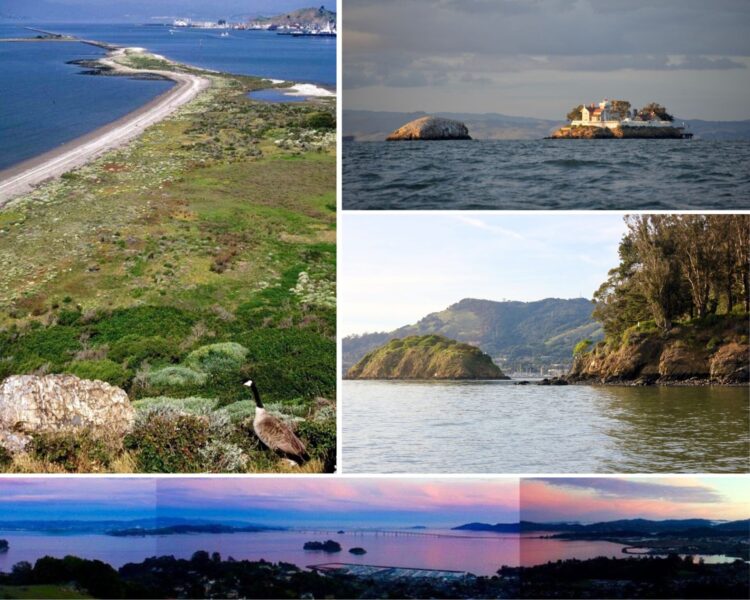
My sailing partner had long been fascinated with Red Rock and proposed that we circumnavigate the humble little island in December 2019, on a day with a crisp, steady breeze. It was a far more exciting loop than I’d imagined. Coming to the lee side of the island, which we left to starboard, we were suddenly sailing in close quarters. The wind shut off, the smell of guano pierced the nose, and everything was oddly quiet — save the clanging of limp sails — as the boat glided through the lee. There was plenty of water on the chart, but there was something intense about being so close to beach and rocks. Red Rock showed dozens of faces during our slow loop, from dark and silhouetted to overwhelming detail as the light shifted, revealing the rugged strata. The lee side of the island is green and shrubby, the weather side bare, worn and harsh, showing the millennia of elements battering earth.
Though we were surrounded on all sides by civilization, Red Rock felt otherworldly, as if we were in some remote corner of the ocean.
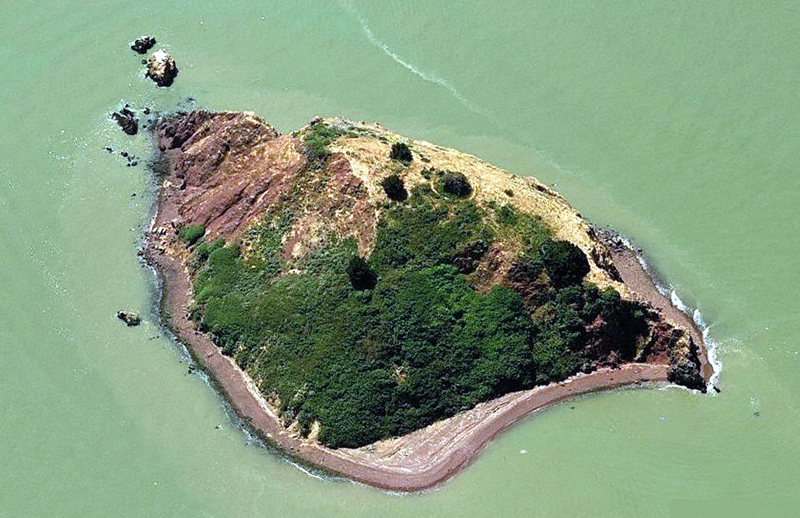
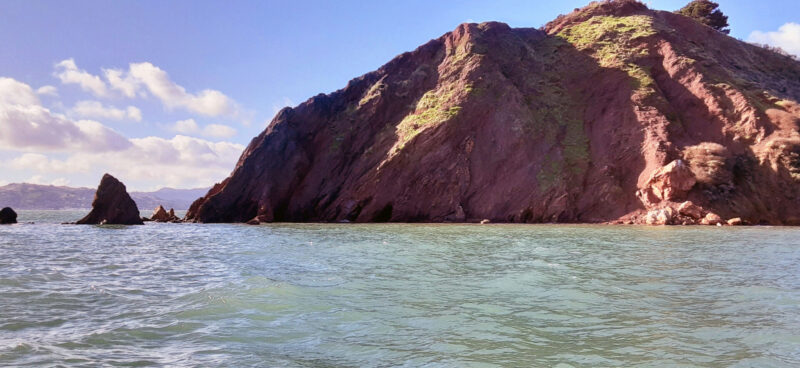
My friend admitted to a fascination with Red Rock, and yes, even a juvenile dream to own it, to plant a flag and call it his. There’s a Tom Sawyer-like boyish allure to Red Rock — or any small island, I suppose — that evokes dreams of adventures and dominion. “It’s like a Bond villain’s secret lair,” my friend said.
I imagine a certain Bay Area tech mogul buying the island, building a giant, ugly, bunker-like mansion with accompanying helipad, and one day shooting phallus-shaped missiles from Red Rock’s interior after the ransom he demanded wasn’t paid.

If it’s sold, it’s not at all clear what a new owner might do with Red Rock. Would someone buy the island and not develop it? Would a gazillionaire leave Red Rock as it is now, frozen in time between epochs, a former small mountain and current small island bereft of fame, but full of charm?
Time will tell.
Got Red Rock stories? Please comment below, or email us here.

Red Rock didn’t sell 11 years ago at a “reduced” price of $9million …why would it sell now for $25million? It crosses into three (3) counties so count on a planning nightmare for any significant development even if it were technically feasible. What type of basic infrastructure (water, sewer, protected cove/landing, power etc) is even possible? Donation to some preservation cause might make sense … but closer to the $50K price last paid for it in the 60’s by attorney Glickman.
BCDC would prevent any development (let alone the other myriad agencies).
I lived in SF in the 90s and as a non-boater at the time, Red Rock was off the RADAR. I wish I knew it better now. Thanks for the report, Tim. This sort of thing disgusts me on many different levels, of which are inappropriate and too hostile to mention here. It’s come to feel like we live in a lords and serfs state.
why is there an Irish flag planted on top of its peak?